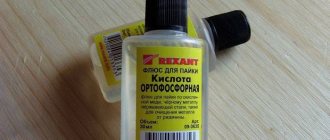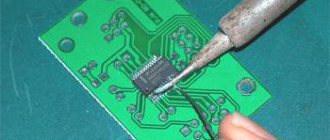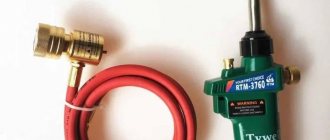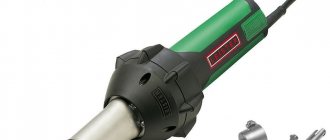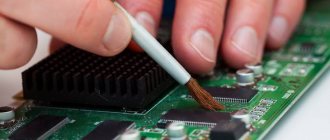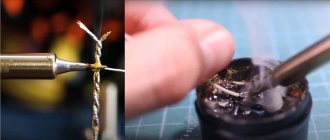Home > Electrician's Tips > How to solder correctly with a soldering iron with acid
Most often, for soldering printed circuit boards in radio engineering products and household appliances, they prefer to use ordinary pine resin rosin, but it can be replaced with other components. When molten, it promotes the spreading of tin solder along the copper traces of the board. This allows you to reliably solder the legs of radio components and the ends of connecting wires. Rosin allows you to effectively solder copper, tin and silver products. In order to solder galvanized and stainless iron, radiators, buckets, pans, various alloys, brass and other metals, you can use acid solutions.
Bottle with acid solution for soldering metals
Acidic solutions
It is important to choose the right acid solution. It depends on the type of metal from which the parts are made. This could be an aluminum or copper radiator, a kettle that needs to be soldered, copper, brass or roofing iron:
- Galvanized iron. Places where it is necessary to solder are treated with an acid solution, correctly called (zinc chlorate). This composition can be bought in specialized stores; the easiest way is to prepare it yourself.
To do this, it is enough to throw pieces of zinc into 100 ml of hydrochloric acid, which can be removed from the body of AA batteries. After the chemical reaction is completed, the zinc will dissolve, releasing a large amount of hydrogen.
It is correct to carry out the process in a well-ventilated area, in the absence of open flame.
After the solution has cooled and settled, the upper transparent yellow part is poured into a clean glass container. The sediment is poured into the ground; it is not recommended to drain into sewers with metal pipes. Acid can damage pipes and seals. The remaining part of the solution is ready for processing galvanized iron roofing.
How to solder sheets of roofing iron
- Stainless steel. Before soldering, the surface is cleaned and treated with phosphoric acid, which contains the following elements:
- up to 50% zinc chloride;
- ammonia up to 0.5%;
- dissolves in water with a pH concentration of 2.9%.
Phosphoric acid is used for soldering as a flux and for cleaning metal from rust.
The solution can be transparent, light yellow or colorless; when heated to 213ºC, it is converted into H4P2O7 (pyrophosphoric acid), which degreases the surface of metals. The composition dissolves the oxide film on various metals and alloys:
- stainless steel;
- brass;
- Nickel alloys;
- copper alloys;
- alloys of carbon metals and low-alloy steel.
How to choose the right one
Phosphoric acid is used in cases where it is necessary to solder parts with complex properties. Often, the flux composition includes orthophosphoric acid (almost three-quarters of the total mass). The additives included in the mixture help with the adhesion of heavy metals.
Manufacturers must rely on the regulatory data of the state standard. But the substance is not always of high quality, since suppliers supply goods of different quality. Therefore, when purchasing acid, you need to pay attention to the following features:
- the quality of the substance is checked according to GOST standards;
- is there any sediment and in what quantity, since it has a negative effect on the soldering of parts;
- the color of the mixture also matters, because a dark shade shows that there are a lot of excess impurities;
- On the contrary, some additives are useful; they improve the properties of the substance.
It is better to avoid using a reagent that has a cloudy dark tone. We must not forget that the shelf life of orthophosphorus is six months. It is not recommended to use the substance further, as it loses its properties.
Before soldering metal elements, experts offer a good way to check the reliability of phosphoric acid:
- Flux is applied to the surface of a metal part or plate;
- the lower part of the element is heated with a burner;
- the solvent begins to evaporate first;
- then the flux spreads out like a white spot.
If small balls appear on the surface of the part, then the substance is not suitable for use. The melt should be evenly distributed over the plate. After the experiment, the surface of the part is washed off well. If the spot under the flux turns out to be clean, then the soldering activity is excellent and the metal has good protection.
Application of acids
To solder metal products (pipes, radiators, buckets, pans), the surface of the elements is thoroughly cleaned, using a file or sandpaper. An acid solution is applied to the cleaned areas with a brush, after which solder is melted to a liquid state on the surface with a soldering iron.
How to solder correctly with a soldering iron
Liquid solder tins the cleaned areas; when boiling, the acid flux comes to the surface. When the solder hardens, the soldered elements are securely and hermetically fixed.
You can solder with a powerful soldering iron or an open flame from a gas burner. Various heat sources can be used depending on the surface area to be heated and the melting point of the solder.
Remains of acid flux are washed off with water, preferably a soapy, alkaline solution, this will prevent further corrosion of the metal.
Machined and brazed stainless steel elements
Acid can damage skin and muscle tissue, and inhaling vapors can damage the respiratory organs. When contacting air, hydrochloric acid enters into a chemical reaction, and smoke is visible above the open container. To work correctly in these conditions, wear safety glasses, rubber gloves, a gas mask, or a respirator.
If the solution gets on the skin, wash this area of the body with a 6% alkaline solution or plain soap. It is not recommended to solder radio circuit boards with fluxes containing acid. The acidic components are difficult to wash off and contribute to the breakdown of copper tracks. It is better to replace them; there is a special paste for this.
Soldering acid solutions should be stored correctly in containers made of the following materials:
- glass;
- ceramics;
- porcelain;
- fluoroplastic
Such dishes do not react with acid; the prepared composition can be stored in it for a long time.
How to treat parts with acid
Liquid fluxes are applied to surfaces with a brush. In this case, a more accurate and uniform wetting of the elements to be soldered is ensured, so the brush should be included in any soldering kit. At the same time, as already written above, both more active fluxes and less active ones, to one degree or another, have a destructive effect on both the connected surfaces and the solder. If the flux is not removed at the end of the work, then on steel parts, for example, rusting processes will occur at a much faster pace.
To prevent this, after soldering, parts coated with flux must be treated with neutralizers. The simplest of them is water. To remove F-38 N, you don’t need to use anything other than it. Soda neutralizes well the effects of hydrochloric, orthophosphoric, and acetylsalicylic acid, as it is a base. After soldering, a soda solution should be applied to the parts, which is then washed off with water. Residues of VTS are removed with alcohol or acetone.
Soldering without a soldering iron
At home, if you don’t have a soldering iron, you can solder copper wires with a diameter of up to 2 mm. For soldering radiators and utensils, special solder, blowtorches, and gas torches are used, since the copper rod of the soldering iron is not able to heat a large surface area. There are several ways:
- Tinning and soldering wires in molten solder . The wire is first heated, applied to a piece of rosin, it melts and spreads evenly over the surface of the connection. The wire is twisted and lowered into molten solder in a tin can over a fire; it can be heated with a blowtorch. In order to solder the twist, it is advisable to hold it in boiling tin for up to 1 minute. The copper wires will heat up and the alloy will fill all the gaps between the twisted wires. In this way you can solder small parts made of copper, brass and other alloys.
Tinned and soldered copper wire
- Soldering wires in the trench . The stripped and twisted wires are laid in a 2-3 cm piece of aluminum tube, 0.5-1 cm in diameter, sawn lengthwise. The top is filled with a mixture of fine shavings of solder and rosin dust, and from the bottom this structure is heated with a lighter, candle or small blowtorch.
Heating the solder with a blowtorch (torch)
The mixture melts and thoroughly envelops all wire connections. After hardening, the aluminum gutter is removed and the joint is insulated.
Solder shavings can be sharpened with a coarse file.
- A thin copper wire up to 0.75 mm can be laid on aluminum foil, sprinkled with a mixture of rosin and tin shavings, wrapped tightly and heated for 3-4 minutes. The solder will evenly fill all the elements at the soldering site; after cooling, the foil can be removed and discarded.
The nuances of using and soldering using phosphoric acid
Due to the fact that orthophosphoric acid belongs to the category of substances harmful to humans, when using it, compliance with safety rules and precautions comes to the fore. It must be stored exclusively in a tightly closed container, and used directly for soldering only in a room where proper ventilation can be ensured.
Be sure to ensure that you have personal protective equipment. If acid does come into contact with the skin, the area must be thoroughly washed under running water and soap.
The soldering process is generally similar to that which takes place when other types of flux are used: the metal surface is first cleaned mechanically, and only then treated with acid. Thanks to this, residual rust and other contaminants are eliminated, as a result of which the quality and reliability of the connections obtained as a result of soldering are significantly improved.
[Acid for soldering is necessary] if the use of rosin does not allow the necessary elements to be properly soldered together.
The use of soldering acid for soldering helps remove the oxide film layer from the surfaces being soldered and makes it possible to properly prepare them for joining.
As a rule, rosin is used to prepare copper parts for soldering with your own hands. But soldering acid is used for tinning not only copper, but also its alloys - bronze and brass.
And also for stainless steel, precious and ferrous metals, aluminum and nickel, even for soldering cast iron.
How to prepare solder paste
Soldering paste is sold in radio parts stores, but you can prepare it yourself. To 32 ml of hydrochloric acid add 12 ml of ordinary water, then pieces of zinc - 8.1 g. For this, enamel dishes are used.
How to tin a soldering iron: preparation and care of the soldering iron
After the dissolution reaction is completed, tin – 8.7 g is added to the composition. When the second dissolution reaction is completed, the water is evaporated to a paste-like consistency of the solution. The paste is transferred to a porcelain container, where powder is poured, which contains:
- lead – 7.4 g;
- tin – 14.8 g;
- dry ammonia – 7.5 g;
- zinc – 29.6 g;
- rosin – 9.4 g.
This paste is mixed with 10 ml of glycerin, heated and stirred.
How to solder correctly, sequence of actions:
- The parts at the soldering site are cleaned, the wires are twisted;
- the paste is applied with a brush in a thin layer;
- the surface for soldering is heated with a plasma lighter, torch, candle or alcohol tablet, or even with matches or over a fire until the paste melts;
- After melting, the soldering elements are removed from the heat source, and the solder hardens.
The paste is very effective when it is necessary to solder copper wire, small parts made of alloys based on copper, brass, such as radiators, samovars and other products.
Fluxes made from aspirin and salicylic acid
One of the craftsmen, not finding rosin or other flux in the house, thought of using ordinary aspirin to treat the elements before soldering. Acetylsalicylic acid tablets can be used to repair household appliances. True, when aspirin is heated, caustic vapors are formed, so you should work with acetylsalicylic flux in a ventilated area. One way to tinning is to sprinkle aspirin powder on the part. In another way, the wires are placed on a whole tablet and heated with a soldering iron.
VTS flux is produced based on salicylic acid, which is often used in electrical installations. This composition provides protection to welded parts from corrosion, so it is preferred when carrying out this type of operation. HTS is used for processing copper and its alloys, as well as elements made of precious metals. The flux contains:
- solution of salicylic acid and ethanol (C2H5OH) – 6.3%;
- triethanolamine – 6.3%;
- technical petroleum jelly – 63%.
Soldering utensils
How to install a socket with your own hands correctly
Buckets and pans with holes no more than 5-7 mm in diameter are recommended to be soldered without using a soldering iron with POS-60 solder. Leaky places on the dishes can be reliably soldered. To do this, the holes are carefully cleaned with sandpaper from the inside of the container. The hole along the edges is given a conical shape, the cleaned areas are treated with a solution of soldering acid with a brush.
In order to prevent solder leakage from the outside, all bottoms or individual places where holes need to be soldered are covered with thin tin plates. Powdered solder and rosin are poured into the cleaned holes from the inside. The soldering areas are heated over an open fire until the solder melts and fills all the cracks.
For radiators, stripping and soldering are carried out from the outside. To prevent solder from leaking inside, the hole is covered with a plate of tin, galvanized iron, or can be replaced with copper or brass. The choice depends on the material from which the radiator is made. Homogeneous metals and alloys that are similar in composition are easier to solder.
After completing the soldering process of radiators, the internal and external surfaces are thoroughly washed with an alkaline, soapy solution in order to prevent the effect of acidic components on the metal.
Bottle with flux for soldering aluminum
When it is necessary to solder aluminum parts, special solders are used:
- 4:1 mixture of tin and zinc;
- 30:1 mixture of tin and bismuth;
- 99:1 tin and aluminum powder.
The sequence of surface treatment is the same as for preparing iron utensils. In order to properly solder aluminum, rosin is added to the powder, but the melting point must be above 500ºC. It is recommended to stir the solder in the hole, using a thin copper soldering iron tip.
Components and physicochemical properties
Orthophosphoric acid has the form of a light yellow solution or a discolored mass. The main component in the composition is zinc chloride, the share of which is at least 50 percent. According to accepted standards, the proportion of insoluble sediment should not exceed 0.001 percent of the total mass of the substance. The allowed ammonia content is within 0.5 percent.
As the formula H3PO4 shows, orthophosphoric acid is tribasic and has medium strength. When interacting with stronger acids, it shows signs of amphotericity, and the result of the reaction is the formation of phosphorite. Contact with water causes the process of electrolytic dissociation to occur.
Acid belongs to the category of substances with a fairly high degree of danger, so when working, care should be taken to prevent it from getting into the eyes and skin through the use of personal protective equipment. It should also be taken into account that due to the aggressiveness of the environment, there is a risk of a negative impact on thin parts and elements. Orthophosphoric acid demonstrates its best qualities when soldering metals with a high melting point.
PCB soldering paste
The composition is not much different from the paste that is used to solder without a soldering iron; the powder includes the following components:
- tin – 14.8 g;
- rosin – 4 g;
- zinc dust – 738 g;
- lead powder – 7.4 g.
For a paste-like consistency, add diethyl ether - 10 ml, it can be replaced, use glycerin - 14 ml.
Soldering sequence:
- the legs and tracks of the printed circuit board are cleaned;
- in order to solder, the legs of the parts are inserted into the holes of the board;
- places where it is necessary to solder on the board are lubricated with paste;
- the paste is heated with a soldering iron until it melts;
- The solder spreads and hardens, providing reliable electrical contact between the parts and the traces of the printed circuit boards.
Precautionary measures
Aggressive properties require a special approach to safety precautions. Storage is carried out in original packaging, protected from direct sunlight.
It is better to carry out work with good ventilation, using the necessary protective equipment.
The skin reacts negatively to aggressive substances. If it gets on your hands, wash it immediately with water and laundry soap. Inhalation may cause oral irritation, and if it gets into the eyes, seek professional help.
The need to use acid fluxes
Any soldering acid - hydrochloric or phosphoric acid - is designed to create an ideal environment for the interaction of solder with elements.
Their use makes it possible to remove contaminants and oxides from the working area, prevent the resumption of the oxidation process and reduce the tension of the solder, in order for it to spread more freely.
As a result, reliable soldering of parts is ensured.
Depending on the type of metal, the flux for soldering is selected. It is worth noting here that soldering acid is not used when assembling boards.
